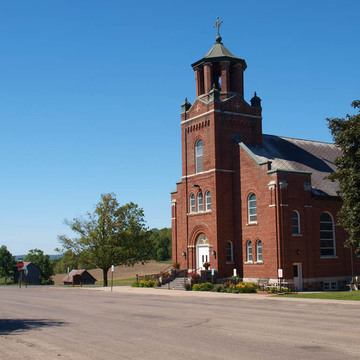The community of Isadore was first known as Four Corners, but renamed in 1890 in honor of the patron saint of farmers. Rising above the farmlands cultivated by generations of Polish Americans, who came here from Milwaukee in the 1870s to farm, are the red brick church, convent (1957), and school, and the cemetery of the Holy Rosary Polish Catholic parish. The parish was organized in the 1880s and built a wood-frame church in 1883 and a school in 1884. In 1922 the church was torn down, and the building committee selected a Milwaukee architectural firm noted for its church designs to plan what it termed a “Roman-style church.” The church is entered through a square central tower that terminates in an open octagonal belfry. Six pairs of stained glass windows depicting Christ's life were executed by the F. X. Zettler Company of Munich and installed in 1922. Inscribed in an arch over the altar are the words “Krolowo Rozanca S W. Modl Sie Za Nami.” Like the church, the square-shaped, hipped-roof school stands on a raised fieldstone foundation. Having ceased functioning as a standard school in 1999, the school houses a religious education program in conjunction with St. Rita/St. Joseph Church in Maple City. Buried in the cemetery are the early settlers and their descendents.
You are here
Holy Rosary Church and School
If SAH Archipedia has been useful to you, please consider supporting it.
SAH Archipedia tells the story of the United States through its buildings, landscapes, and cities. This freely available resource empowers the public with authoritative knowledge that deepens their understanding and appreciation of the built environment. But the Society of Architectural Historians, which created SAH Archipedia with University of Virginia Press, needs your support to maintain the high-caliber research, writing, photography, cartography, editing, design, and programming that make SAH Archipedia a trusted online resource available to all who value the history of place, heritage tourism, and learning.















